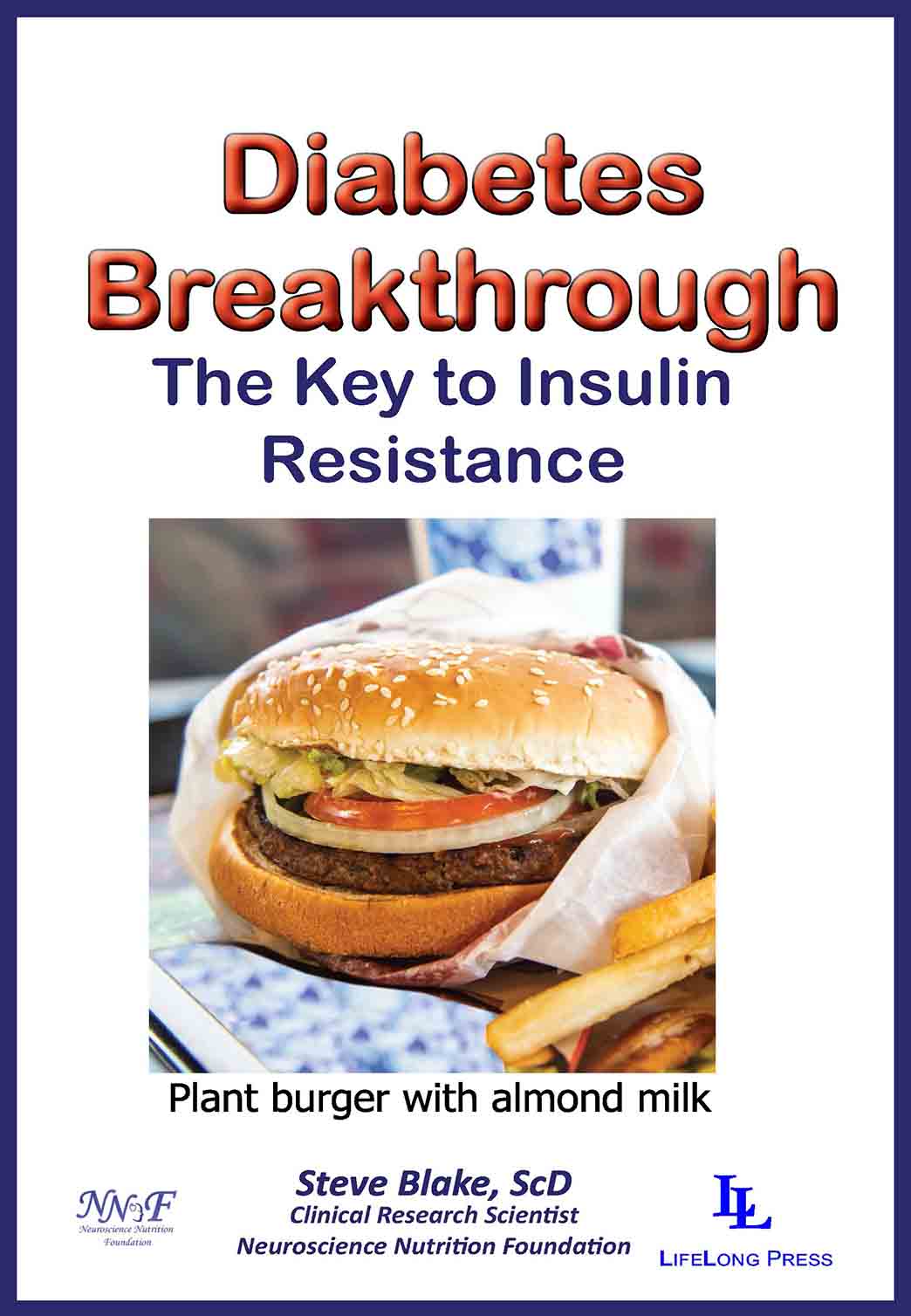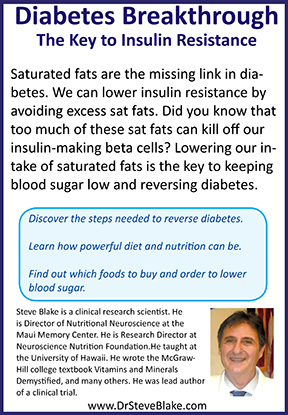
Diabetes Breakthrough:
The Key to Insulin Resistance
September, 2019
Saturated fats are the missing problem in diabetes.
Did you know that saturated fat excesses
kill off our insulin-making beta cells?
Less saturated fat is the way to lower insulin resistance.
This is the key to keeping blood sugar low and
reversing diabetes. I will give you a plan to beat diabetes.
My hope is that this book helps you as much
as it has helped those we have worked with,
Steve Blake, author.
$9.95 to download the entire 162 page book
Click Below (I will send download instructions by email):
Below is a video describing parts of my approach to
reverse diabetes:

Please see below for the table of contents and Introduction.
Table of Contents
Table of Contents
Introduction
Table of Figures
Part I: How Saturated Fats Influence Diabetes
Chapter 1: What is type 2 diabetes?
Types of diabetes
Do drugs protect people with diabetes?
Developing type diabetes
To reverse type diabetes
What is insulin?
Antioxidants and glycation
Slow carbohydrates
Diabetes diagnosis
Liver production of blood sugar
Signs of diabetes
Chapter 2: Complications of diabetes
Low blood sugar
Hypertension
High blood fats, dyslipidemia
Diabetic retinopathy
Kidney damage in diabetes
Nerve pain and sensations, polyneuropathy
Amputations
Diabetes and cancer
Alzheimer's disease and diabetes
Chapter 3: Saturated fat creates insulin resistance
Liver insensitivity to insulin
Saturated fats
The worst sat fats
We can make sat fat from excess calories
Sat fats reduce insulin receptors
Saturated fats and energy production in the mitochondria
Sat Fats, inflammation, and insulin resistance
Risk of diabetes on different diets
Chapter 4: How glucose gets into cells
What insulin does
Glucagon puts sugar into the bloodstream
How the liver makes blood sugar
How glucose gets into cells
Summarizing the steps
How excess sat fats block glucose
Dietary sources of sat fat
Chapter 5: Strategies to help diabetes
Vitamin D may reduce blood sugar
Chromium helps reduce blood sugar
Heme iron from meat and diabetes
Medical plants that reduce blood sugar
Chapter 6: Protecting our beta cells
When beta cells cannot detect high glucose
Beta cells and palmitic acid
Even type diabetes can be eased
Obesity and diabetes
Excessive sugar, diabetes and heart disease
Chapter 7: Studies that reverse diabetes
The Majuro Study
Dr. Barnard's Diabetes Reversal
Reversing diabetes with very low sat fats
Part II: The Plan for Reversing Diabetes
Chapter 8: Carbohydrates and diabetes
Minimize refined carbohydrates
Maximize whole plant carbohydrates
Eat food with a low glycemic Load
A high fiber diet is perfect for diabetes
Chapter 9: Less fat and better fat
Avoid excess saturated fats
Dairy products without the dairy
Avoid all trans fats
Get enough omega- fatty acids
Adding flax to boost EPA
More inflammation with arachidonic acid
Fish oil for omega-s
Contamination of fish oil
Rancid fish oil
Chapter 10: Plant antioxidants
Diets high and low in antioxidants
Antioxidants that we make in our bodies
Chapter 11: Damaging dietary pollutants
Hormones in food
Heavy metals in food
Cooked fats
Oxidized cholesterol
Advanced glycation endproducts
Acrylamides
Chapter 12: Exercise and fitness
Chapter 13: Reverse Diabetes in two weeks
Index
Reference Citations
Table of Figures
Increase in Type 2 Diabetes
Structure of dangerous saturated fatty acids
Diet patterns and incidence of diabetes
How glucose gets into the cell
How excess sat fats keep glucose in the blood
Sources of excess sat fat in an American diet
Majuro study changes in weeks
Majuro study reduction in medications
Dr. Barnard's trial reduction in glucose and cholesterol
Reduction in blood sugar in one week
Graph of blood sugar with fast and slow carbohydrates
Glycemic load chart of fruit
Reducing diabetes risk with fruit and berries
Saturated fat in common foods
Meat alternatives
Adding flax powder improves diets
Antioxidant content of diets (red = deficiency)
Acrylamides in different foods
Introduction
There is a breakthrough in treating diabetes. For too long,
we have been looking only at how sugar gets into the blood.
Now, we need to look closer at how sugar gets out of the blood.
Sugar has a hard time getting out of the blood
if there is too little insulin or when there is insulin resistance.
Dietitians and doctors need to learn to treat insulin resistance.
The clinical studies are clear: we can reduce insulin resistance
to clear the blood of excess sugar. This can only be done
with adjustments to the diet. We need to take
charge of our health and make the changes that will reverse diabetes.
What is really wonderful about diabetes is that it can be
reversed in some cases. Reversal is what this book is about.
The American Diabetes Association, many registered dietitians,
and many doctors who treat diabetes are going to counsel
you to restrict sugars and fast-releasing carbohydrates.
If you are thinking that this is somehow going to make
diabetes go away, it doesn't work. Diabetes is not going to be
reversed with normal medical treatment; it stays the same or it gets worse.
Insulin resistance is created by a constant stream of excess saturated fats.
These excess saturated fats also have a prominent role in killing off the
beta cells that make insulin in our bodies. Even worse, the
insulin resistance causes the liver to produce blood sugar,
even when it is already high. These concepts are a breakthrough
in understanding type 2 diabetes.
Type 2 diabetes is defined by insulin resistance and the animal fats that create it.
"Very quickly I started to feel better. The cramps in my
legs disappeared and I no longer had get up during the
night to go to the bathroom. My sugars kept dropping
and are now normal without any medication.
My last lab tests show that I am no longer diabetic.
People can hardly believe what has happened to me"
Tinar
